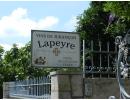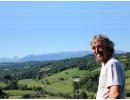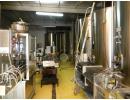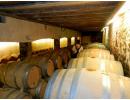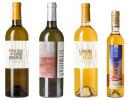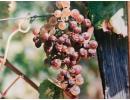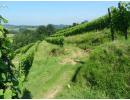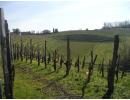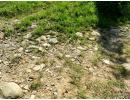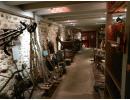Clos Lapeyre
Clos Lapeyre "La Magendia" - Jurançon
A premium "Vendanges Tardives" late harvest wine, made from 100% Petit Manseng. The vines are an average of 30 years old planted on terraces. The yield is low at an average of 30 hl/ha obtained by the "passerillage" (dehydration of the grape) method. The grapes are handpicked with 3 to 5 successive pickings from late October to early November. The fermentations using indigenous yeasts take 2-3 months in oak barrels of which 1/3 are new. The wine is aged in the same oak barrels for 12 months then a further 6 months in stainless steel vats before bottling. No malolactic fermentation is carried out. The average residual sugar is 90 g/l depending on the vintage.
PVins notes: The wine's colour is light yellow in its youth, the nose is complex with confit tropical fruits aromas and notes of honey and quince. The wine is well balanced by the freshness and the oak is well integrated, a nice persistent finish. It is a sweet wine that does not feel over sweet as the terroir and the Petit Manseng grape provide a good acidity. It is preferable to cellar the wine for about 2 years in its youth and its ageing potential is 10 to 15 years.
Clos Lapeyre is located 4 kms south-west of the village Jurançon in the Chapelle de Rousse district. Jean Larrieu purchased the estate in 1920 which had a small area of vines. Later his son Marcel continued with the family's farm growing strawberries, breeding cows and cultivating 3.5 ha of vines, the grapes were then sold to the local cooperative at Gan. Between 1972 and 1975 he planted 5 ha, from which 3 hectares were planted on terraces. These terraces were amongst the first planted in Jurançon.
In 1985 a new chapter started, after completing studies in oenology and viticulture, Jean-Bernard Larrieu representing the 3rd generation, decided to build a small cellar with the help of his father and bottle his own wines, Clos Lapeyre was born. The cellar was extended in 1989-1990 and again in 1994 to increase storage space for the oak barrels. Over the same period he replanted the farm's land with vines, about one hectare at a time, to reach a vineyard of 10 ha by early 2000. In 2004, the estate was increased to 18 ha following the purchase of Domaine de Nays-Labassère, a well situated estate of 7 ha planted with old vines. In 2002, as Jean-Bernard Larrieu wanted to make highly expressive wines which reveal the Jurançon terroir and express the local spirit, he started converting Clos Lapeyre to organic farming and succeeded by obtaining an "organic certification" in 2005. Since the certification Jean-Bernard has gone a step further by implementing biodynamic farming since 2013.
French version
Clos Lapeyre's 18 ha of vines are situated on the upper slopes at an altitude of 350 to 400 metres, with different exposures varying from south to south-east and south-west. Because of the steepness of the slopes, 9 ha of vines are situated on terraces of a height of 6-8 metres with some in an amphitheatre formation facing the Pyrennees. On terraces vine plantation is low at about 1000 vines per hectare. Clos Lapeyre has about 60% of its vineyard planted with Petit Manseng and the remainder is planted with Gros Manseng and some Petit Courbu planted in the 1940's. Throughout its recent history, the estate has been busy replanting parcels at different stages with the highest part of the Clos Lapeyre replanted between 1982 and 1984. Between 1991 and 1993, another two parcels were planted with Gros Manseng and Petit Manseng. The magnificent "amphitheatre of Ducos" set on terraces was planted between 1994 and 1998, exclusively with Petit Manseng. Recently they have planted some Courbu and Camaralet vines chosen by massale selection. The average yield per hectare on the estate has been reduced over the years, with the conversation to organic vine growing and improved management of the vineyard over time, the yields have dropped from 42 hl/ha in 2001 to 30 hl/ha in 2007. These low yields which concentrate the grapes have improved the quality of the wines and expression of the terroir, resulting in 2 to 3 kilograms of Petit Manseng being needed to obtain one litre of juice when for normal grapes it is 1.3 kilograms.
Regarding the soils, as the estate is located in the heart of the appellation, the native rock is composed of the famous chalky limestone conglomerate of Jurançon. The topsoil is made up of thin layers of sandy clay, silt and alluvium deposits with its famous limestone pebbles, locally known as "poudingue de Jurançon". These pebbles often lay on top of the soil sometimes in localised patches notably on the southern slopes. The diversity of the land, with its numerous geographical faults and important leaching, gives a great variety of different soils which in turn demand different cultivation methods. In order to control each parcel of vines differently, in 1999 Jean-Bernard mapped out all the different soils at Clos Lapeyre according to the most ancient method "la Méthode Hérody". By assessing each surface and the depth of each soil and analysing soil samples, they divided the 12 hectares of vineyard into 15 different types of soils (amongst which some are inevitably very similar). This mapping enables the estate to adapt the work in the vineyard with a "parcellaire" (parcel) approach, maintaining the health of the soils and vines in order to maximise the expression of Clos Lapeyre's terroir in the most natural way possible which includes biodynamic farming.
The estate produces 3 tiers of wines, from early drinking to Super Premium in both Jurançon Sec and Jurançon appellations. For the dry whites, depending on the vintage and the physiological maturity of the grains, the grapes may be de-stemmed or pressed as whole bunches, pre-fermentation skin maceration for 5-6 days may be done. The wine making process is adapted to each wine, some will be fermented and aged in oak barrels and for some the malolactic fermentations will not be done to keep the natural acidity.
Here is a summary of the various premium wines produced by Jean-Bernard:
"Vitatge Vielh" (dry) meaning old vines, comes from a 1.80 ha parcel of 50 year old vines. The blend is about 60% Gros Manseng, 30% Petit Manseng and 10% Petit Corbu. The wine is fermented in demi-muid barrels of 600 litres (none new), the ageing will last 12 months in oak barrels followed by a further 6 months in stainless steel vats for the wine to settle before bottling. Pale gold in colour, muscaty notes from slightly "passerillage" grapes, dried fruit and brioche. Beautiful freshness on the palate. An elegant wine with well integrated oak flavours, long finish. Medium term cellaring.
"La Magendia" (sweet) meaning the "Best" in Occitan, is a late harvest "Vendanges Tardives" made from 100% Petit Manseng hand-picked end of October or early November depending on the vintage. The wine is a perfect example of the "passerillage" method on vines requiring 3 to 5 pickings. The fermentations can take several months in french oak barrels, then the ageing in the same oak barrels (33% new) will last for at least 12 months. The residual sugar is on average 90 g/l. A complex nose of sweet tropical fruits and honey, well balanced by the freshness from the terroir and the grapes which carries through the long finish.
The following 2 wines are only produced if the vintage conditions are at their optimum, these are medium to long term cellaring wines.
"Montoulan" (dry) is a 1.60 ha parcel located 500 metres to the west of Clos Lapeyre, the first vintage was 2006. It is planted at a high density of 5,400 vine per hectare producing a yield of 30 hl/ha. the wine is produced with "selection massale" grapes representing a blend of 70% Petit Manseng, 15% Camaralet and 15% Corbu. The wine is fermented in french oak barrels, then aged for 12 months in the same barrels, malolactic fermentations are carried out, the wine is then aged a further 6 months in stainless steel vats to settle before bottling. Complex exotic, citrus fruits on the nose, full-bodied, great balance on the palate between the richness and acidity.
"Vent Balaguèr" (sweet) named after the warm southerly winds coming over the Pyrennes from Spain, the wine is only produced weather permitting. Another exceptionnal late harvest "Vendanges Tardives" made from 100% Petit Manseng. The grapes are usually picked about 2 weeks later then those of the cuvée "La Magendia". For this exceptional cuvées, following the harvest the grapes are laid in trays called "clayette" to perfect the process of concentration by “passerillage”. These trays are laid outside in the sun during the sunny winter days and brought inside the cellar on damp and rainy days, the process will last a couple of weeks. Besides dehydrating, the grapes change in colour, turning from a golden-yellow to russet and finally brown. Such is the concentration that about 4-5 kilograms of grapes are need to produce just one litre of juice with a the residual sugar of 160 g/l depending on the vintage. The wine is barrel fermented for several months and then aged in oak barrels for up to 2 years. A very complex nose of gingerbread, fruit paste, honey, spices, dried apricot and confit orange zest. The richness and concentration are balanced by a superb lemony acidity on the lingering finish.
Links: South West map - www.vins-jurancon.fr
JURANCON
The Jurançon appellation was created in 1936 and the Jurançon Sec (dry) in 1975. The area is located in the South-West of France near the town Pau at the foothills of the Pyrenees Mountains. It spreads over 25 communes in the Pyrénées-Atlantiques Département and it is named after the village of the same name.
History
The vineyards date back over 2,000 years when the Romans settled in the area. The first recorded transaction of Jurançon wine dates back to 998 by the Abbaye de Saint-Vincent at Lucq-de-Béarn. In the 15th century, the largest estates are in the hands of the Lords and the Viscounts of Béarn who settled in Pau in 1460, this is the beginning of the golden age of the vineyards of Jurançon. In 1538, the grape's name "Mansenc", known as Manseng today, appeared and also the use of the name Jurançon came into place as King Henry II of Navarre purchased some vines. In 1553, the future King of France Henry IV, born in Pau, was Baptised with Jurançon wine. As early as the 16th century, the princes of Béarn and the Parliament of Navarre introduced the notion of "cru" depending on the quality of the parcels. This was the first attempt of classification in France, long before all other vineyards to preserve the authenticity of the wines of Jurançon. Towards the end of the 19th century the majority of the vineyard had disappeared due to the phylloxera, but since the early 20th century the vineyards are being replanted and steadily expanding.
Vineyard
The appellation stretches 40 kilometres from a south-east to a north-west orientation. The 1,000 hectares of vineyards are situated at the foothills of the Pyrenees between the river Gave de Pau to the north and Gave d’Oloron to the south. The vineyards are often planted facing south to south-west on very steep slopes providing good drainage, they are sometimes set on terraces and even in an amphitheatre formation at an altitude of 250 - 400 metres. The ideal vineyards are situated towards the top of the hills, facing south in an amphitheatre formation which helps to retain the heat. Jurançon's ideal terroir was created during the geological formation of the Pyrenees, which was the result of the collision between the micro-continent Iberia and the southwestern part of the European Plate between 25 to 100 million years ago. After the uplift and reaching an altitude of about 3,400 metres at its pick, the chain experienced intense erosion and glacier activity modifying the surrounding landscape. This developed 3 types of terroirs in the appellation. To the South, the sub soil is derived from flysch and limestone (marine sedimentation) deposited before the formation of the Pyrenees. In the center, the soil is composed of limestone pebbles, locally known as "poudingue de Jurançon" and gravel deposited by rivers and creeks during the formation and erosion of the Pyrenees. These limestone pebbles often cover soft structured clayey-sandy and clayey-siliceous soils and concentrated patches of pebbles can be found in some areas. To the north, the terroir is clayey siliceous with some gravel and pebbles.
Only white wines are produced as Jurançon Sec (dry) and Jurançon (sweet). The history and reputation of Jurançon wine comes from its sweet wines, they range from semi-sweet (moelleux) to very sweet (liquoreux/doux). The five grape varieties planted are: Gros Manseng with 65% of the vineyard, Petit Manseng representing 30% and Petit Courbu, Camaralet with Lauzet representing 5%. The "Mansengs" are amongst the latest ripening varieties, which bud very early (end of March) and ripen very late (October or November). They have an unusually long ripening period. They grow very tall and require high trellising systems that are strong enough to resist the westerly winds, the planted rows stand like mini-walls of vegetation at about 2.5 metres in height. The Jurançon Sec has to have a sugar residual nearing 4g/l which gives them a little roundness but remaining dry in style, they are mainly Gros Manseng based and sometimes blended with Petit Corbu and/or Petit Manseng. They are fruity wines showing notes of citrus fruits with hints of white flowers. The Premium dry wines are often barrel fermented and aged offering more complexity with a little more cellaring potential.
As for the sweet Jurançon they must contain a minimum of 35g/l of residual sugar, both Gros Manseng and Petit Manseng are used. The best wines are usually made from 100% Petit Manseng as it is a very good grape for late harvesting "Vendanges Tardives" (mention since 1996) due to its resistance to botrytis, it also produces high sugar levels and has a good acidity for balance in the wine. These late harvest wines are made by using the "passerillage" technique, the process of dehydration of the grape, rather than botrytis. This is achieved by leaving the grapes to dry on the vine and sometimes partially in the cellar. The harvest must be hand-picked with at least 2 pickings. This will give time for the grapes to slowly dry up and concentrate the sugar level in the grains while still on the vine. The botrytis doesn’t really develop here and is not welcomed like in Sauternes (Bordeaux). This phenomena is possible with the help of the Foehn effect, a warm southerly wind coming over the Pyrenees from Spain especially in autumn, which encourages optimal maturation of the grapes by keeping them dry. The grapes are handpicked from October to December. Should the weather conditions be ideal, usually excellent vintages, grapes may be picked late in December and left to dry further in the cellar. This very late picking and drying process will produce extremely low yields and high residual sugar, this is usually reserved for the production of Super Premium cuvées. The sweetness in the wine is always balanced by the natural acidity in the grape and terroir conditions, also no malolactic fermentation is carried out helping to keep the freshness in the wine. The Premium wines evolve from light yellow to a deep golden colour with age, the aromas are complex showing white flowers, vanilla, honey and tropical fruits confit. These Premium wines are often barrel fermented and aged and have a long cellaring potential.
Climate
The local climate is unique as it is influenced by micro-climates. With the Atlantic Ocean only 100 kilometres to the west, the region experiences Oceanic conditions with its fair share of rainfall with about 1,200mm per year. The Pyrenees Mountains influence is also felt by cool temperatures and the clouds often covering the area providing a "green house" effect. Then you have the warm southerly winds of the Mediterranean called "foehn" also locally named "Vent Balaguer" that flow from Spain over the Pyreenes during summer and particularly autumn. These winds are very beneficial to the "passerillage" effect to produce the sweet wines and keep the grapes dry in general. In some areas semi-tropical vegetation such as palm trees, fig trees and banana trees can be found.



